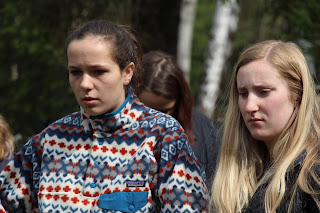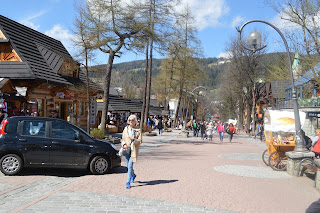Today we headed south to visit two
cities: Rabka Zdroj and Zakopane. There would be no rain today but the morning
was overcast. We hoped for the
best. We would not be disappointed.
Artwork by Gayle Bart HST 2014 - The Story of Rabka
As we left Krakow, Paulina told us
about the ties of Pope John Paul II, now Saint John Paul, to this area. Born Karol Wojtyla in Wadowice, near Krakow,
in 1920, he grew up in an apartment building which was owned by a Jewish
family. He grew up with many Jewish
friends. He also was an avid sportsman
who loved hiking and skiing in the Tetra mountains bordering Slovakia that we
would see today. He was named Archbishop
of Krakow in 1964, made a cardinal in 1967, and was elected Pope in 1978. He visited Poland during the communist era
and is credited with helping to bring about the fall of communism in Poland, he
was the first pope to visit the State of Israel and in 1985 he initiated the
first World Youth Day. The first World
Youth Day, put on by the Catholic Church every 3 years is a one week event which
draws millions of young people. This
year the WYD will again be held in Krakow and they are expecting more than two
million participants.
Our first stop on today’s journey was
the small town of Rabka Zdroj, often just referred to as Rabka. We learned that many of the towns in this
area also have ‘zdroj’ [meaning ‘spa]]
added to their name. This area of Poland is well known for a number of spa
towns and health resorts. Rabka has
been a source of fresh air for people suffering from lung ailments and
allerties for more than a century.
We were here to visit a Jewish cemetery
we had first visited in 2012 and again in 2014.
We trudged up the hill until we were before a convent, then took a path
which led into the woods. Before we
headed into the woods, Shalmi stopped and wanted to give us the context for
what we were about to see. Before the
war, there was a Jewish community here in Rabka, and although the exact
numbers are unknown, they were probably about 1/3 or perhaps more of the
townspeople, inasmuch as much of the health business was in the hands of
Jews. There was also a convent here; the
same building but run by a different order.
During the war the Gestapo took over part of the convent and used it as
a school for interrogation. Part of the
experiential learning phase necessitated that they practice on human subjects,
and members of the Jewish community were to serve this function. Their interrogation practices involved
torture and ended when the subject was dead.
They then just threw the bodies out behind the convent building. The sisters knew that they were Jewish and
wanted to give them a respectful burial, but they knew nothing about the Jewish
rituals for burying the dead. They knew
the Germans would not approve, and they were possibly risking their lives, so
in secret, they dragged the bodies from behind the convent into the woods where
they buried the corpses, one by one, trying as best they could, to provide a
respectful burial.
After the war, the convent never spoke
of or publicized what they had done---it was a hidden cemetery. And to some degree, it remained a hidden
cemetery. Four years ago, we had attempted
to talk to the new order of sisters about the cemetery but they said they knew
nothing and did not encourage us to go see it.
There was also a neighbor who watched us trek into the woods and was
visibly upset with our presence. The
same had been true of our last visit here, in 2014. But, Shalmi had said, before we entered the
woods, we think the mayor is paying attention to the site.
We waded through muddy sections of the
unmarked, often barely distinguishable path, going around the convent building
and into the woods. And suddenly was we
turned a corner, we came upon a scene which was surprising and shocking. A theme of this trip does seem to be
emerging: that change can happen, and we
can each be a part of that change.
Before us was a stone path, with a bridge constructed over the stream,
with railings which led to the Jewish cemetery which was now marked by an
information guidepost marker stating what had happened here. Inside the cemetery, it was obvious much work
had been done. The weeds had been
pulled, the trees and shrubs had been pruned and one could see the memorial
markers and the grave sites.
Shalmi then spoke to us about other
people who didn’t have to act, but did so just because it was the right thing
to do, such as these nuns. One story
that came to mind was that of the Bulgarian Jews, who numbered about
50,000. Bulgaria had allied with Germany
during WWII in the hopes of acquiring territory from Greece and
Yugoslavia. In 1943 Nazi Germany
notified the Bulgarian government that the Bulgarian Jews were to be deported
to Nazi-occupied southern Poland. The
patriarch of the Bulgarian Orthodox Church, Archbishop Stefan, ultimately
decided to act to oppose the deportations, found out where the Jews had been
rounded up and went there, to a school.
When he asked to come in, he was denied access to the Jews. He climbed over the wall and went to the
Jews, telling them not to register, but to go home. When questioned by the authorities as to what
he was doing, he asked them what they
were doing and threatened to excommunicate them if they proceeded with the
deportations. The Jews returned
home. Later King Boris, under public
pressure, officially forbade the deportations.
Bulgaria’s Jews were saved and after the war about 80% emigrated to
Israel.
Shalmi revisited the subject of
leadership and change. People often
prefer not to take the initiative if the matter does not concern them. But if you have a leader, who shows the way,
there can be positive change. We
remembered Jan Masaryk and how as President he changed the status of Czech Jews
in his country, so much so that they would sing the Czech national anthem as
they walked to the gas chambers in Auschwitz.
Of course, much evil has also been done because of leadership, so it is
important that people take responsibility for their actions, monitor their
governments and leaders, and be willing to speak up and become involved when
they know that to take action is the right thing to do. Not for glory and praise – but because it is
the right thing to do.
While we were there a family came to
the cemetery and the parents and two young children walked respectfully around
the cemetery as we were talking. We had
never before seen anyone in the cemetery.
We chose to take the easy path out, to see if there was a marker on the
street, which there was, a signpost reading “Jewish Wartime Cemetery”.
The next stop was just for fun: Zakopane.
As we left Rabka, the weather had turned absolutely beautiful and we
had a warm and sunny day in this ski resort town in the Tetra mountains. This was a favorite spot for Krakow Jews
before the war, for skiing. Many photos
and videos we had seen in the Berlin Jewish Museum had been filmed in
Zakopane. We tried oscype,
the local smoked cheese which was delicious, marveled at the beautiful scenery
and the wooden architecture for which the region is known and the wonderful
floral folk costumes. We took the
funicular to the top of the mountain from where we could see the city of
Zakopane below, the spectacular view of the “Sleeping Giant’, and walked along
the ridge, having a photo stop as several students posed for pictures with a
lamb and dog. We had some time left for
shopping in the market for gifts before heading back to Krakow. Yesterday had been a difficult day --- today
was such a positive day; seeing change and celebration of actions by good
people during the war, and just enjoying the food and culture of a beautiful resort town.

































The town looks like it holds a lot of history of the holocaust and it is every history nerds dream to see it.
ReplyDeleteSuch a nice surprise to find out that the hidden cemetery is now being acknowledged. So glad you had such a beautiful day to just enjoy the scenery. The lamb and the dog are adorable.
ReplyDeletewow very good Awesome blog and pics with nice informations - tempo traveller hire in delhi / my tempo traveller, tempo traveller on rent in delhi, tempo traveller hire, india tours, tempo traveller on rent at cheap and best price..
ReplyDeletenice blog, Experience the incredible trip to rajasthan with Ajinkya tours, rajasthan tour packages and make mesmerizing vacations.
ReplyDeletehttp://www.ajinkyatours.in/Rajasthan.aspx
http://www.ajinkyatours.in/Kashmir_tour.aspx
That's great travel blog which really fantastic trip enjoy with the tourism of Uttarakhand. It really amazing trip for the hotels tour. Discount Airline Tickets
ReplyDeleteWOW fantastic pictures with amazing information thanks for sharing blog.
ReplyDeletesame day tajmahal tour packages
Same Day Agra Tour
Delhi to Agra trip by car
Delhi Agra One Day Tour
One Day Agra Tour
Agra Day Tour Packages
Fabulous Pictures!
ReplyDeleteMount Shasta Tour is the perfect place to enjoy the outdoors.
You can register for free online education courses with certifications on education portals.
ReplyDeletehello admin
ReplyDeletethis is lepassagebureau
we are a tours and travel company
please visit our pages
Jaipur Private Tour
Myself Lucky Vashishtha, I am working in tourism industry from last 15years as an approved tour guide from ministry of tourism. I travelled all over the India with my guests ,after that I have decided to open my own travel company #ANAISHA JOURNEY, it was very challenging, but anaisha journey made it possible after providing best services, informations, innovative tours, best luxury hotels, transportation. Anaisha journey noida Agra based company now one of the best travel Company in India.
ReplyDeleteBest Of South India Tour with Kerala 15 Nights 16 Days
Highlights Of South India Tour
Enchanting Kerala Tour Packages
4 Nights 5 Days Tamilnadu Tour
10 Days Best Itinerary of Rajasthan Tour
Rajasthan Camel Safari tour 16 Nights 17 Days
Thanks and best regards
Lucky Vashishtha
www.anaishajourney.com
+919997959209
+916395366927